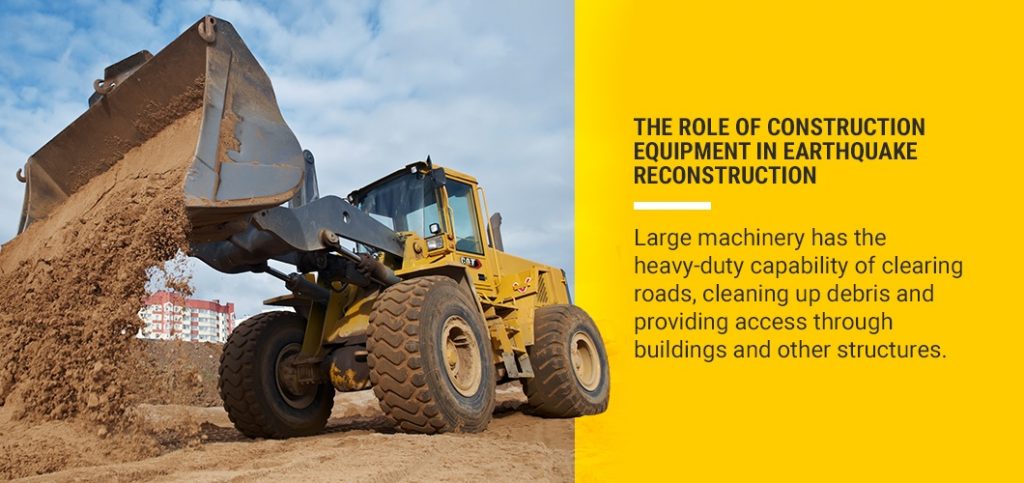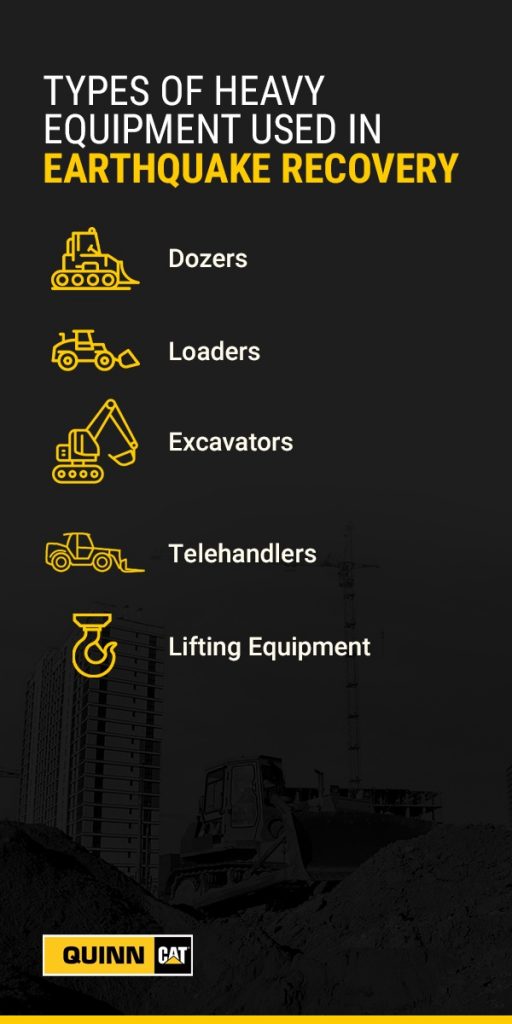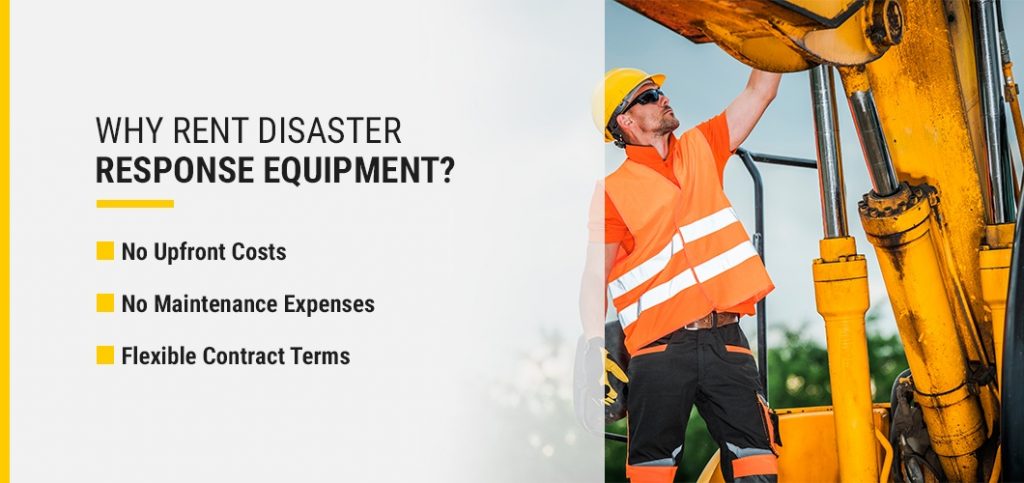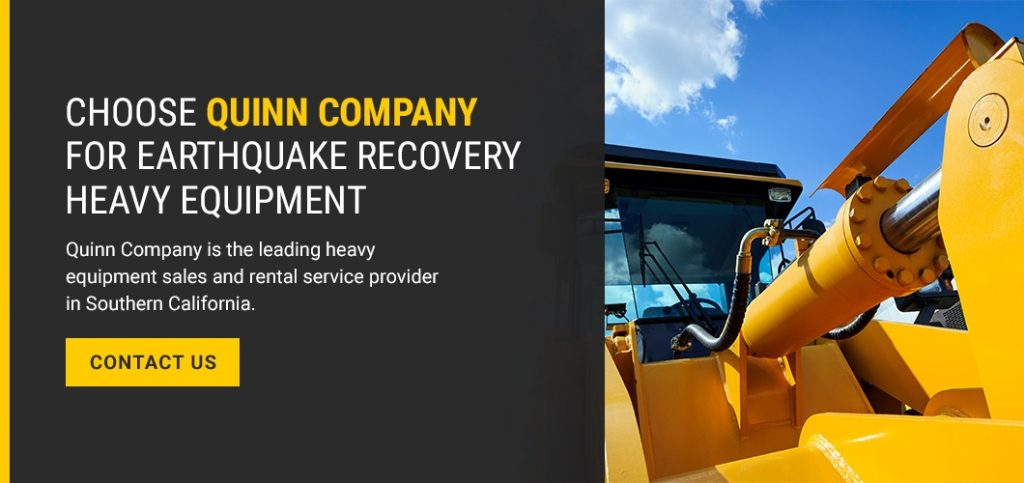Earthquakes can wreak havoc on public infrastructure and buildings. Many people will immediately require emergency services for those injured or affected by rubble and debris. Heavy equipment typically used in the construction industry can assist with cleanup and reconstruction after an earthquake. Some machines can move large amounts of debris quickly to make way for emergency crews. Others can carefully lift building materials to free trapped people or access barricaded areas. In this guide to earthquake recovery, we’ll discuss heavy equipment and its applications for natural disaster assistance.

The Role of Construction Equipment in Earthquake Reconstruction
Immediately after an earthquake, infrastructures — including roads, buildings, power lines and bridges — have been compromised in some way. There may be varying levels of deconstruction with anything from minor damage to piles of rubble and debris.
The first thing everyone needs to do after an earthquake is call for emergency support. Firefighters, paramedics and even police assist people who have become trapped in the rubble and debris or who are injured and need medical attention. First responders need clear and safe passage via roadways to make it to the victims. If emergency vehicles can’t reach their destination, first responders lose precious time.
Heavy construction equipment for earthquake recovery comes in to free up roadways quickly and safely. Large machinery has the heavy-duty capability of clearing roads, cleaning up debris and providing access through buildings and other structures. Emergency services can then reach those who need them.
Firefighters, paramedics and police do not have the appropriate machinery to deal with a large-scale earthquake. As a result, they’ll look to local construction crews to support them in their efforts. The Federal Emergency Management Agency (FEMA) and the military, or more specifically Army engineers, possess machinery to deal with large-scale catastrophes such as earthquakes. Still, they take time to mobilize, and in the context of a severe earthquake, quick response time means saving more lives.
Emergency crews most often need large pieces of machinery like dozers, wheel and track loaders and backhoes, which can quickly move large amounts of debris after an earthquake. Other pieces of construction equipment, such as generators, lights, fans and pumps, are essential. They help emergency responders save people and make areas safe and habitable again in different ways:
- Generators and lights: During an earthquake, electrical services are often disabled due to fallen power lines and destroyed power stations. Nearly all modern equipment used in search and rescue efforts requires electricity to operate, and that’s where generators come in. These mobile power plants can supply energy to various emergency operations. They’re also useful in powering mobile lighting towers, which provide much-needed lighting for emergency crews searching for missing people.
- Pumps: Big earthquakes tend to destroy concrete structures and plumbing facilities. That destruction can often cause large amounts of water to fill low areas, including basements and building foundations. Crews use pumps to remove standing water quickly so they can enter these spaces.
- Fans: Dangerous gases, like natural gas, are often released during an earthquake when underground pipes rupture. Gases quickly fill spaces, creating a life-threatening situation for crews and trapped civilians. By using fans, responders can get fresh air circulating, potentially saving lives.

Types of Heavy Equipment Used in Earthquake Recovery
Earthquakes can devastate infrastructure, reducing buildings, roads and bridges to rubble in a few short minutes. Immediately after an earthquake has passed, people begin calling for emergency responders for themselves and others around them.
To reach people, emergency crews need to travel by road to the areas devastated by the earthquake. For this to happen, roads must be cleared of hazards like downed power lines, fallen buildings, collapsed bridges, floodwaters, trees and more.
Many local jurisdictions can’t equip their emergency response personnel with heavy equipment. Instead, they may extend the responsibility of providing this essential service to heavy equipment operators and contractors who own and know how to operate the machinery. In many instances, those who don’t own their machinery will rely on heavy equipment rental providers. With rentals, operators can quickly access the necessary machinery and lend a hand with the cleanup and reconstruction efforts.
Whether services rent or own machinery, heavy equipment for earthquake recovery is essential. Each type of machine has unique benefits and features that make it ideally suited for emergency relief, cleanup and reconstruction efforts.
Cat Dozers
Dozers are master path builders. Their power enables them to push everything from trees to concrete to cars to create a usable path. They’re an essential tool in the timeframe after an earthquake, as emergency personnel must be able to locate people in need of medical attention.
Smaller to mid-sized dozers, like the Cat D4 Dozer, Cat D5 Dozer, or Cat D6 Dozer provides a similar function, easily displacing dirt, building materials or debris. One great benefit of the smaller models is their size. Smaller machines can fit in locations a larger dozer might not be able to, like in densely spaced urban environments.
Cat Loaders
Loaders are essential pieces of equipment in industrial and construction settings because they’re incredibly versatile. They can push and move material around like a dozer. But their ability to scoop and lift their bucket to load material into a dump truck for transportation makes them highly useful. There are two categories of loaders that could be useful for earthquake recovery efforts:
- Track loaders typically have a lower center of gravity and greater traction due to their tracks. They can scale steeper slopes and operate on the softer ground while their weight stays evenly distributed over a larger area.
- Wheel loaders typically have a higher center of gravity, making them slightly less stable on sloped surfaces. Their weight is not as evenly distributed compared to track loaders, which makes them less capable of traversing softer terrain like mud or loose soil. Though this may seem like a disadvantage during an emergency, wheel loaders are faster, and their maneuverability makes them valuable in the right scenario.
Larger loaders, like the Cat 962 Wheel Loader, are powerful machines capable of moving large amounts of materials. In a post-earthquake environment, they can be an essential tool to remove debris from roadways or clean up demolished building materials.
Smaller loaders, like the Cat 299D3 XE Compact Track Loader, can operate in a wide range of spaces due to their compact size and ability to turn in a tight radius. That function can be very beneficial in areas where earthquake damage won’t permit larger machines to access.
Cat Excavators
In situations where rubble and debris have trapped individuals, crews must lift building materials delicately until the people underneath can be rescued. This process requires careful, stable digging and lifting capability to ensure the rubble doesn’t further collapse.
Excavators provide the fine articulation needed to lift debris one piece at a time and do so gently enough to not disturb the compromised building structure. Excavators vary in size from mini to very large, and their usefulness depends on their application.
Smaller excavators, like the Cat 306 CR Mini Hydraulic Excavator, can fit into tight locations most commonly found in urban settings. Their relatively smaller bucket and thumb allow for more agile movements, which is essential in removing building materials safely.
Larger excavators, like the Cat 374 Hydraulic Excavator, offer vast amounts of power and material moving potential. They can quickly move large debris and clear paths for emergency crews where smaller machines would struggle. The drawback of such a large machine is its larger bucket and thumb — it isn’t able to make the delicate movements smaller excavators can. Larger excavators are better suited for removing large amounts of rubble that crews are certain don’t have people trapped underneath.
Cat Telehandlers and Lifting Equipment
Telehandlers and similar lifting equipment bring materials and personnel to high levels. They’re an excellent resource during earthquake reconstruction because they can safely bring down materials.
The Cat TL642D Telehandler provides up to 30 feet of reach and can offer speeds up to 21 mph. It’s a versatile and helpful piece of equipment when you need to move supplies to higher places or bring down debris.
Why Choose Cat Equipment for Earthquake Recovery?
Earthquakes can devastate our infrastructure and communities. After an earthquake, everyone bands together and supports each other. They also realize how important it is to clear debris so that emergency services can move freely and begin cleanup efforts and reconstruction, starting the process of returning to normal.
When the call goes out to local operators for recovery assistance, the last thing anyone wants is ineffective equipment that can’t stand up to the rigors of disaster response. That need for dependability is why so many contractors and operators choose Cat heavy equipment.
Since 1925, Caterpillar has helped its clients build a better world through its products and services. Their experience in heavy equipment design, manufacturing and service has spanned nearly a century and has established them as the industry leader in reliable and robust heavy equipment.
The Caterpillar Foundation was started in 1952 with the mandate to improve people’s lives around the world. They achieve this by serving communities in need during and after natural disasters. This commitment means that Caterpillar is invested in designing and manufacturing equipment that can stand the test of disaster relief. Cat equipment is made to perform under the toughest conditions, including earthquakes, and they have a trusted reputation and decades of experience to back up their machines and services.

Why Rent Disaster Response Equipment?
Earthquake emergency response can be a dynamic situation with many variables. In times of distress, emergency response personnel depend on local contractors and operators to assist them in clearing response routes to travel to people in need. They rely on heavy equipment contractors and their operators to help them achieve safe access to areas that have seen large-scale structural collapse. Those contractors and operators effectively become a part of the rescue and recovery team.
There’s a wide variety of disaster response work that needs to be tackled after an earthquake. From flooding to electrical fires, the results of earthquakes test infrastructure at every level. Crews then need many different models of equipment assembled into a responsive, versatile fleet.
To ease the economic burden during an emergency earthquake cleanup, renting equipment can be an excellent choice. So why rent emergency response equipment? It’s an on-demand option, meaning you can quickly secure the right equipment and ramp up operations without delay, essential in times of emergency. The flexibility in rental contracts also means that your crew can extend your rental agreement for as long as needed until the recovery job is done. Need more reasons why you should choose rental equipment for emergency response? Consider these benefits:
1. No Upfront Costs
Renting equipment doesn’t require a sizable upfront purchase cost like buying does. The lack of upfront fees means there’s no hassle to secure financing and worry about interest rates. Renters of heavy equipment also aren’t faced with a break-in period. Rented equipment from a reliable rental provider is good to go the moment it arrives at your site. You’ll never need to worry about long-term storage locations and costs or insurance fees, either.
2. No Maintenance Expenses
Rental service providers perform all of the maintenance required to keep heavy machinery running smoothly and reliably. Experienced technicians put each piece of equipment through a detailed inspection to ensure everything is running perfectly before it arrives. They’ll also replace parts when components begin to show wear or are due for replacement. Knowing you’re renting well-serviced, high-quality equipment gives you peace of mind during an emergency.
3. Flexible Contract Terms
Renting equipment is an economical and extremely convenient option, especially during the time after an earthquake when your equipment needs might fluctuate from day to day, depending on the situation.
Rental equipment for disaster response allows you to choose from flexible rental terms, whether you need to use the equipment for a week, a month or even longer. Following an emergency and during the recovery process, having a rental company by your side is a significant benefit.
Choose Quinn Company for Earthquake Recovery Heavy Equipment
Quinn Company is the leading heavy equipment sales and rental service provider in Southern California. With multiple convenient locations throughout the state, Quinn can meet your equipment needs anywhere, anytime.
We know our clients require the hardest-working, most reliable equipment on the planet, and Caterpillar delivers. To learn more about emergency heavy equipment rentals, contact Quinn Company today, or give us a call at 888.987.8466 to speak to a knowledgeable representative.


